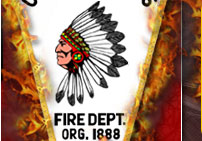|

TOP HAZARDS OF TRICK-OR-TREATING:
Vehicle Pedestrian Accidents: Children are four times more likely to be struck on Halloween than on any other evening of the year. Adults should always accompany children.
Non-Intersection Crossings: Well over half of the Halloween pedestrian fatalities involving children occur at non-intersections, suggesting that crossing in the middle of the block, darting out from between parked cars and other unexpected crossing behaviors may have contributed to their deaths. the middle of the block, darting out from between parked cars and other unexpected crossing behaviors may have contributed to their deaths.
Falls: Falls are one of the leading causes of injury on Halloween night. While it is important to make sure costumes are "fall-proof," it is also important to clear walkways, yards and driveways of tripping hazards in advance and to carry a flashlight.
Burns and Eye Injuries: Medical professionals cite an increase in eye and burn-related injuries on Halloween night. Paying attention to children's costumes, using face paint instead of masks and using "soft" toy weapons can help reduce these risks.
HALLOWEEN SAFETY CHECKLIST:
Buy only costumes, wigs and props labeled flame-resistant or flame-retardant. If you are making your own costume, choose material that won't easily ignite if it comes in contact with heat or flame. Stay away from billowing or long trailing fabric. If your child is wearing a mask, make sure the eye holes are large enough so they can see out; consider non-toxic and hypoallergenic makeup or a decorative hat as a safe alternative for masks.

Provide children with lightweight flashlights to carry for lighting or colored glow sticks as part of their costume.
Think twice before using simulated knives, guns or swords. If such props must be used, be certain they do not appear authentic and are soft and flexible to prevent injury.
It is safest to use a flashlight or battery-operated candle in a jack-o-lantern. If you use a real candle, use extreme caution. Make sure children are watched at all times when candles are lit. When lighting candles inside jack-o-lanterns, use long, fireplace-style matches or a utility lighter. Be sure to place lit pumpkins well away from anything that can burn and far enough out of way of trick-or-treaters, doorsteps, walkways and yards.

Remember to keep exits clear of decorations, so nothing blocks escape routes. Take extra effort to eliminate tripping hazards on your porch and walkway. Check around your property for flower pots, low tree limbs, support wires or garden hoses that may prove hazardous to young children rushing from house to house.
Tell children to stay away from open flames. Be sure they know how to STOP, DROP and ROLL sho uld their clothing catches fire. (Have them practice, stopping immediately, dropping to the ground, covering their face with hands, and rolling over and over to put the flames out.)

Use flashlights as alternatives to candles or torch lights when decorating walkways and yards. They are much safer for trick-or-treaters, whose costumes may brush against the lighting. Decorations are the first thing to ignite in more than 1,000 reported home fires each year.
Teach children their home phone number and to how call 9-1-1 if they have an emergency or become lost. Remind them that 9-1-1 can be dialed free from any phone.


|







